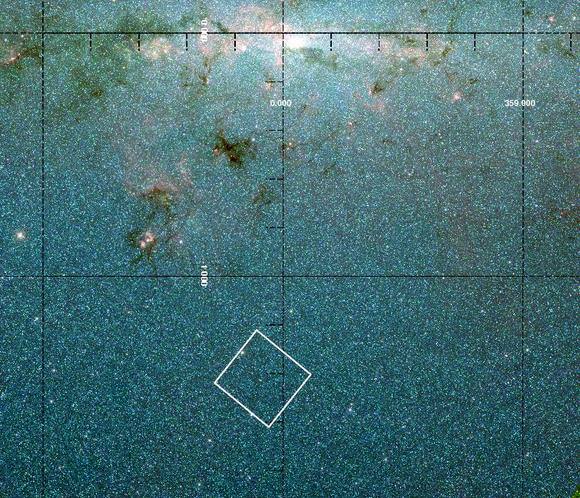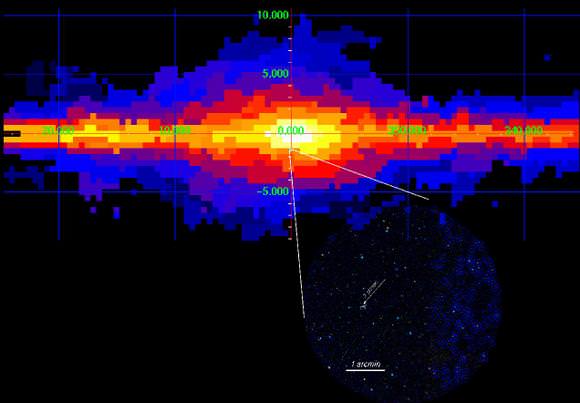[/caption]
The map above details the Galactic ridge X-ray emission, first detected 25 years ago and observed recently by NASA’s Rossi X-ray Timing Explorer (RXTE) observatory. The inset shows the zoomed Chandra image of the region, close to the center of the galaxy.
The mysterious — and formerly blurry — X-ray source puzzled astronomers for a quarter century, but a new paper release today by the journal Nature has helped to clear the air.

Lead author Mikhail Revnivtsev, of Munich Technical University in Garching, Germany, and his colleagues report that the formerly unresolved X-ray glow has a spectrum characteristic of a hot (100 million degrees Kelvin) optically thin plasma, with a prominent iron emission line.
But the gravitational well of the Galactic disk is far too shallow to confine such a hot interstellar medium; it would flow away at a velocity of a few thousand kilometers per second, exceeding the speed of sound in the gas.
Replenishing such energy losses would require a source that exceeds all plausible energy sources in the Milky Way — including supernovae — by orders of magnitude, they write.
Based on their observations, the team is proposing that the hot plasma is instead bound to many faint sources: plain old stars.
“Here we report that at energies of 6–7 keV, more than 80 percent of the seemingly diffuse X-ray emission is resolved into discrete sources, probably accreting white dwarfs and coronally active stars,” they write.
“Such stellar X-ray sources are of the common ‘garden variety’ in the Sun’s neighbourhood,” writes Michael Shull, an astrophysicist at the University of Colorado at Boulder, in an accompanying editorial. “However, at the distance of the Galactic ridge from Earth, their combined light becomes a diffuse blur, the X-ray equivalent of the many stars that make up the Milky Way, as Galileo first saw with his telescope in visible light.”
Shull notes that the results are a testament to the increased power of telescopes like Chandra, which de-mystified the source of the X-ray glow — and he cautions astronomers about describing faint backgrounds at all wavelengths, before getting a good look.
“As Revnivtsev and colleagues’ work demonstrates, sometimes the exotic explanation can be set aside by more accurate imaging and spectroscopy,” he writes.
LOWER IMAGE CAPTION: Region close to the Galactic Center obtained by Spitzer infrared telescope in three spectral band. The field of view of CHANDRA is shown by the white square. Credit: M. Revnivtsev
Source: Nature


Any links to a (free) version of this paper or a preprint?
“100 degrees Kelvin”: that’s not so warm…
10 exp something (about 6 or 7?) would be more like it.
And ‘kelvins’ is better than ‘degrees Kelvin’.
In the article below, the temperature is described as “100-million-degree gas.”
http://www.eurekalert.org/pub_releases/2009-04/cxc-rag042909.php
Couldn’t find the actual paper, though.
Thanks!
I was still a bit chilly then!
Sorry, Jon, I wasn’t able to find a free version of the paper either. And — oops — 100 million degrees indeed. Change made. Thanks!
Amazing, just as predicted a few years back. So the diffuse X-ray glow from the center of the galaxy has been resolved into many individual X-ray sources. What a great confirmation of theory and congrats to the team making the marathon observation. Thanks all for the paper search. It may be available in the next few days, I guess. My understanding is that this result was obtained with an (equivalent) exposure time of 12 days! with Chanda.
Just as I had hoped, the 16 page preprint can be found here: http://arxiv.org/PS_cache/arxiv/pdf/0904/0904.4649v1.pdf . Have to give this a good looking over!
Great work. It makes the case for the continual increase of observational firepower in my books!